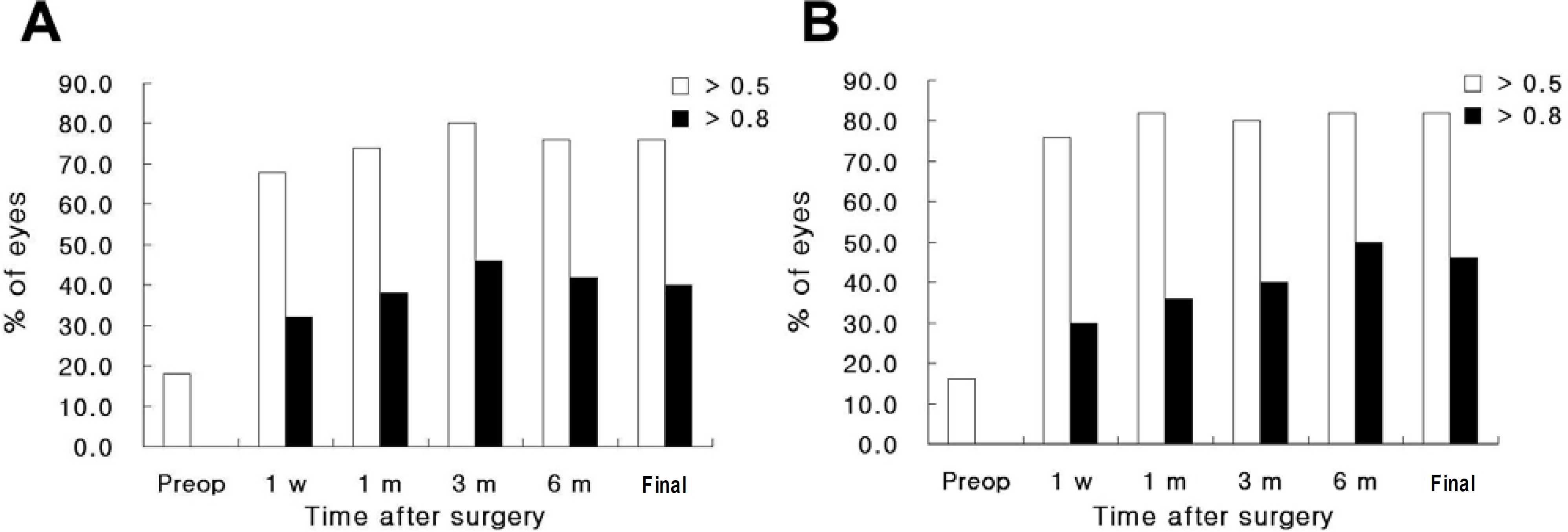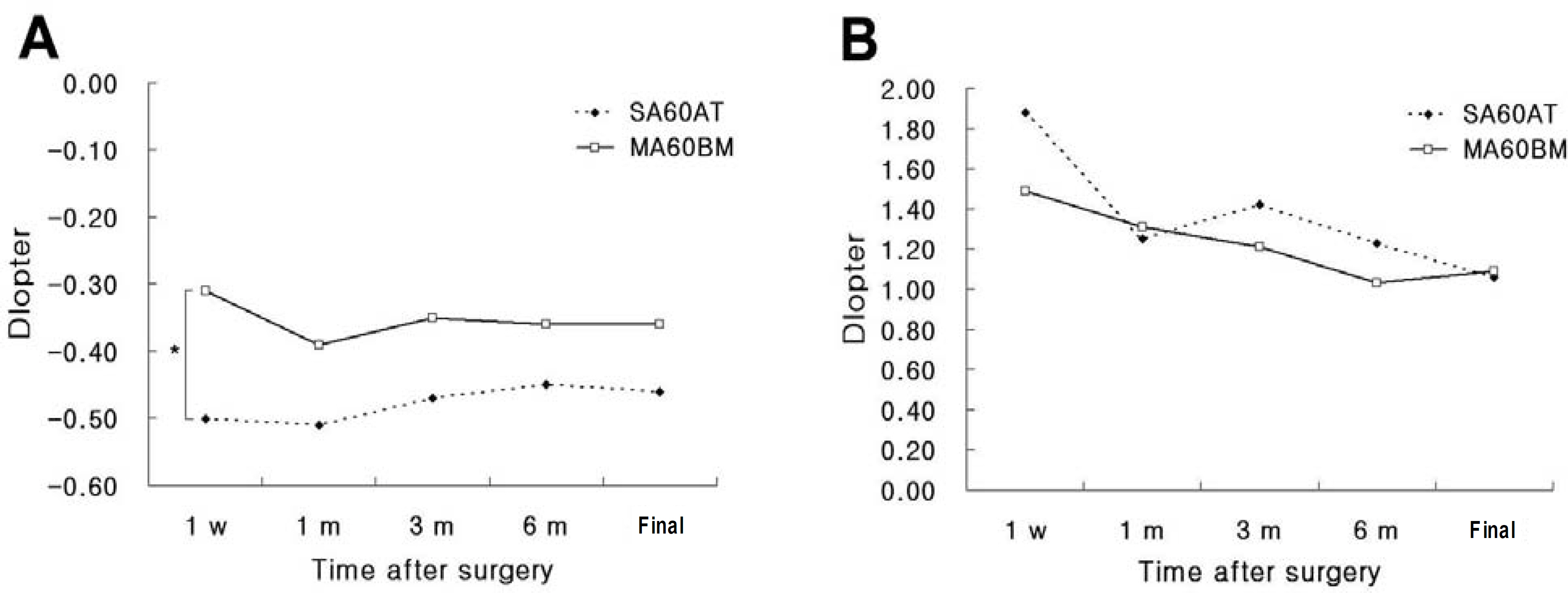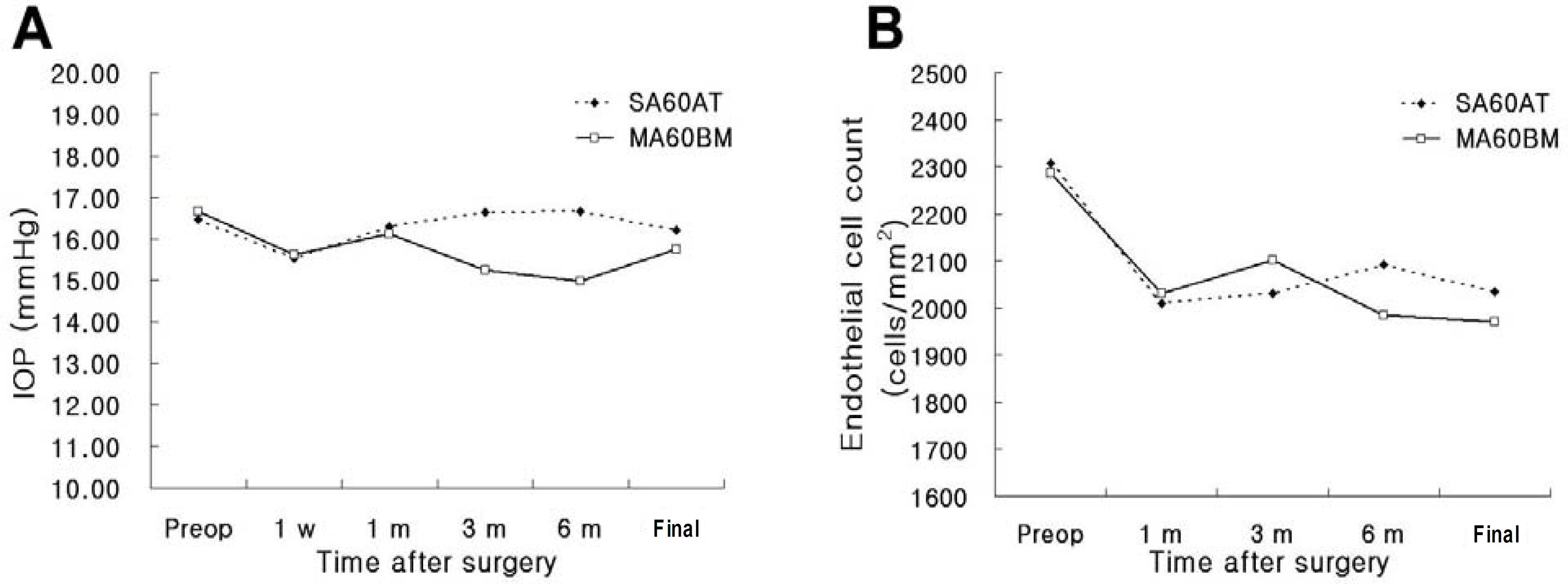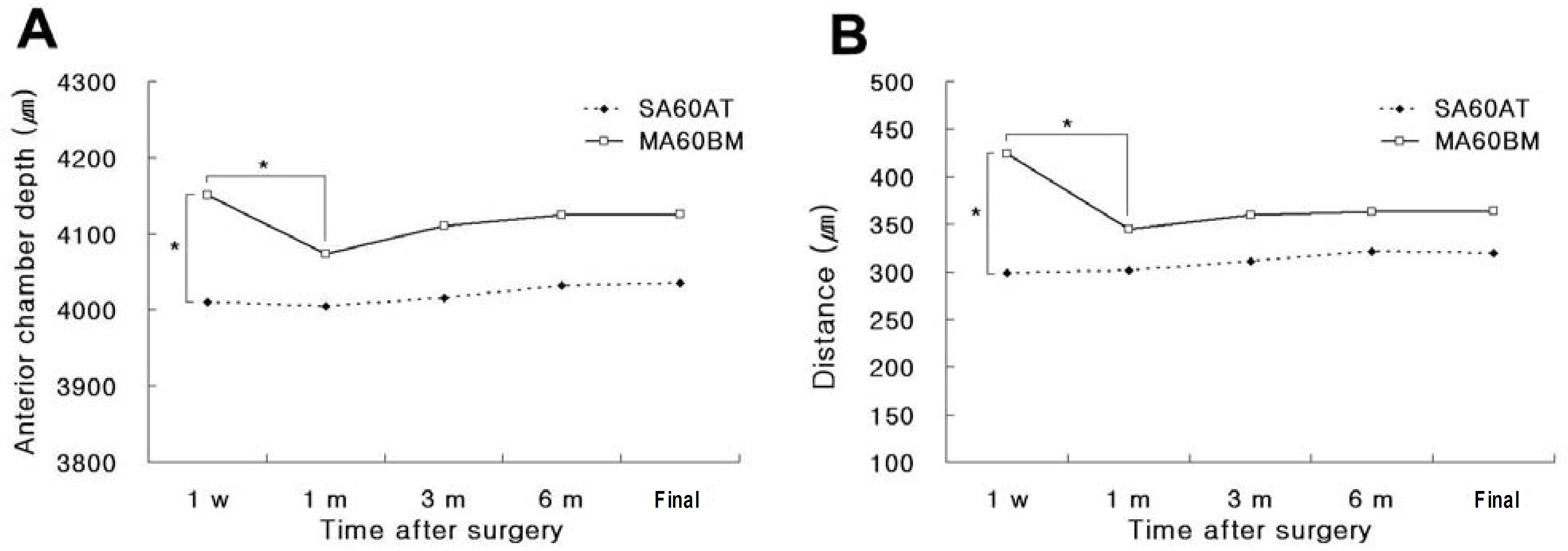J Korean Ophthalmol Soc.
2008 Feb;49(2):245-252. 10.3341/jkos.2008.49.2.245.
Comparison of Long-Term Results between One-piece and Three-piece Acrylate Intraocular Lens
- Affiliations
-
- 1Department of Ophthalmology, Chonnam National University Medical School & Hospital, Chonnam National Research Institute for Medical Sciences, Gwangju, Korea. kcyoon@chonnam.ac.kr
- KMID: 2127115
- DOI: http://doi.org/10.3341/jkos.2008.49.2.245
Abstract
-
PURPOSE: To compare the long-term clinical results of one-piece Acrysof(R) (SA60AT) hydrophobic acrylic intraocular lens (IOL) implantation compared with implantation of three-piece Acrysof(R) (MA60BM) hydrophobic acrylic IOL.
METHODS
We retrospectively analyzed each 50 eyes of 50 patients underwent MA60BM or SA60AT IOL implantation and followed for at least 6 months.
RESULTS
Final visual acuity of 0.5 or better was 38 eyes (76%) and 0.8 or better was 20 eyes (40%) in the SA60AT group. In the MA60BM group, it was 41 eyes (82%) and 23 eyes (46%) respectively. There were no significantly differences in predictability, intraocular pressure, endothelial cell density, astigmatism, and incidence of posterior capsule opacification between the two groups. Spherical equivalent at postoperative 1 week was -0.50+/-0.95D in SA60AT group and was -0.31+/-0.88D in MA60BM group (P=0.04). However, there was no significant difference between the two groups during follow up period. In MA60BM group, anterior chamber depth (P=0.02) and distance between iris and IOL (P=0.04) reduced significantly during the first postoperative month.
CONCLUSIONS
Early postoperative axial displacement and changes in spherical equivalent can be occurred in MA60BM group. However there was no difference in long-term clinical results between SA60AT and MA60BM groups.
MeSH Terms
Figure
Cited by 1 articles
-
Comparison of Visual Function Among Aspheric Intraocular Lenses
In Seong Kang, In Cheon You, Yeoung Geol Park, Kyung Chul Yoon
J Korean Ophthalmol Soc. 2009;50(5):691-697. doi: 10.3341/jkos.2009.50.5.691.
Reference
-
References
1. Kohnen S, Ferrer A, Brauweiler P. Visual function in pseudophakic eyes with poly (methyl methacrylate), silicone, and acrylic intraocular lenses. J Cataract Refract Surg. 1996; 22:1303–7.2. Hayashi K, Hayashi H, Nakao F, Fumihiko H. Reduction in the area of the anterior capsule opening after poltmethymethacrylate, silicone, and soft acrylic intraocular lens implantation. Am J Ophthalmol. 1997; 123:441–7.3. Magual E, Garcia J, Elvira JC, Hueso JR. Clinical results of AcrySof intraocular lens implantation. J Cataract Refract Surg. 1998; 24:114–7.4. Oshika T, Suzuki Y, Kizaki H, Yaguchi S. Two year clinical study of a soft acrylic intraocular lens. J Cataract Refract Surg. 1996; 22:104–9.
Article5. Ursell PG, Spalton DJ, Pande MV, et al. Relationship between intraocular lens biomaterials and posterior capsule opacification. J Cataract Refract Surg. 1998; 24:352–6.
Article6. Cha YD, Oh SH, Lee DH. Comparative assessment of clinical results in various acrylate IOLs. J Korean Ophthalmol Soc. 2006; 47:740–7.7. Choi JA, Kim TI, Tchah HW. Aberration change in pseudophakia with three types of acryl intraocular lens. J Korean Ophthalmol Soc. 2004; 45:405–12.8. Oh SH, Kim JK, Lee DH. The clinical results of hydrophobic single-piece acrylic intraocular lenses after cataract surgery. J Korean Ophthalmol Soc. 2004; 45:2007–13.9. Seo JH, Kim KB, Seo JB. A clinical comparison of Acrysof with hydrophilic acrylic IOLs. J Korean Ophthalmol Soc. 2001; 42:266–71.10. Nishi O, Nishi K. Effect of the optic size of a single-piece acrylic intraocular lens on posterior capsule opacification. J Cataract Refract Surg. 2003; 29:348–53.
Article11. Caporossi A, Casprini F, Tosi GM, Baiocchi S. Preliminary results of cataract extraction with implantation of a single-piece AcrySof intraocular lens. J Cataract Refract Surg. 2002; 28:652–5.
Article12. Meacock WR, Spalton DJ, Boyce JF, Jose RM. Effecct of optic size on posterior capsule opacification: 5.5mm versus 6.0 mm AcrySof intraocular lenses. J Cataract Refract Surg. 2001; 27:1194–8.13. Mian SI, Fahim K, Marcovitch A, et al. Nd:YAG capsulotomy rates after use of the AcrySof acrylic three piece and one piece intraocular lenses. Br J Ophthalmol. 2005; 89:1453–7.
Article14. Sacu S, Findl O, Menapace R, et al. Comparison of posterior capsule opacification between the 1-piece and 3-piece Acrysof intraocular lenses: two-year results of a randomized trial. Ophthalmology. 2004; 111:1840–6.15. Bender LE, Nimsgern C, Jose R, et al. Effect of 1-piece and 3-piece AcrySof intraocular lenses on the development of posterior capsule opacification after cataract surgery. J Cataract Refract Surg. 2004; 786–9.
Article16. Byeun SH, Kim WS. Comparision of the three different hydrophilic acrylic intraocular lenses. J Korean Ophthalmol Soc. 2006; 47:1561–7.17. Wirtitsch MG, Findle O, Menapace R, et al. Effect of haptic design on change in axial lens position after cataract surgery. J Cataract Refract Surg. 2004; 30:45–51.
Article18. Seong MC, Kim MJ, Choi CY, Tchah HW. Clinical results of single-piece hydrophilic IOL after cataract surgery. J Korean Ophthalmol Soc. 2006; 47:1394–400.19. Lane SS, Burgi P, Milios GS, et al. Comparison of the biomechanical behavior of foldable intraocular lenses. J Cataract Refract Surg. 2004; 30:2397–402.
Article20. Nejima R, Miyata K, Honbou M, et al. A prospective, randomised comparison of single and three piece acrylic foldable intraocular lenses. Br J Ophthalmol. 2004; 88:727–8.
Article21. Cho HJ, Woo JM, Yang KJ. Ultrasound biomicroscopic dimensions of the anterior chamber in angle closure glaucoma patients. Korean J Ophthalmol. 2002; 16:20–5.22. Yoon KC, Park SW, Song BY. The role of ultrasound biomicroscopy in operation for limbal dermoid. J Korean Ophthalmol Soc. 2004; 45:364–9.23. Spaeth GL, Azuara-Blanco A, Araujo SV, Augsburger JJ. Intraobserver and interobserver agreement in evaluating the anterior chamber angle configuration by ultrasound biomicroscopy. J Glaucoma. 1997; 6:13–7.
Article24. Choi HY, Jun RM, Choi KR. Ultrasound Biomicroscopy (UBM plus, model P45, Paradigm). Intraobserver reproducibility and agreement of measurements. J Korean Ophthalmol Soc. 2003; 44:1112–7.25. Oh DE, Jun RM, Choi KR. Quantified values of anterior segment in normal adult koreans using ultrasound biomicroscopy. J Korean Ophthalmol Soc. 2004; 45:251–8.26. Sorenson AL, Holladay JT, Kim T, et al. Ultrasonographic measurement of induced myopia associated with capsular bag distention syndrome. Ophthalmology. 2000; 107:902–8.
Article27. Manabe S, Oh H, Amino K, et al. Ultrasound biomicroscopic analysis of posterior chamber intraocular lenses with transscleral sulcus suture. Ophthalmology. 2000; 107:2172–8.
Article28. Erickson P. Effects of intraocular lens position errors on postoperative refractive error. J Cataract Refract Surg. 1990; 16:305–11.
Article29. Petternel V, Menapace R, Findl O, et al. Effect of optic edge design and haptic angulation on postoperative intraocular lens position change. J Cataract Refract Surg. 2004; 30:52–7.
Article
- Full Text Links
- Actions
-
Cited
- CITED
-
- Close
- Share
- Similar articles
-
- Assessing Refractive Stability after Cataract Surgery in Axial Myopes: One-piece and Three-piece Intraocular Lenses
- Clinical Outcomes of Aspheric 1-Piece (Tecnis(R) ZCB00) and 3-Piece (Tecnis(R) ZA9003) Aspheric Intraocular Lens for 12 Months
- Scleral Fixation of a Single-Piece AcrySof Toric Intraocular Lens: A Case Report
- Comparison of Anterior Chamber Parameter and Refractive Change between Three-Piece and Single-Piece Aspheric Intraocular Lenses
- Decentration and Tilt of Posterior Chamber Lens According to Anterior Capsulotomy







